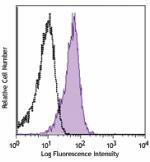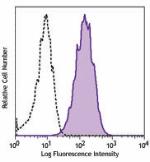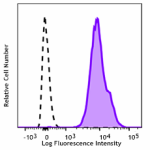- Clone
- RG9-35 (See other available formats)
- Regulatory Status
- RUO
- Other Names
- Lgals9, Gal-9, Ecalectin
- Isotype
- Rat IgG2a, κ
- Barcode Sequence
- ATCCCTGTCAACCGA
| Cat # | Size | Price | Quantity Check Availability | ||
|---|---|---|---|---|---|
| 136117 | 10 µg | $369.00 | |||
Galectin-9 is a mammalian lectin with a molecular weight of 40 kD that has two conserved carbohydrate recognition domains (CRDs) and forms homodimers. It recognizes N-acetyllactosamine (Galbeta1-4GlcNAc) and T-antigen (Galbeta1-3GalNAc). Tim-3 has been reported as its ligand. Galectin-9 is expressed by lymphocytes, dendritic cells, granulocytes, eosinophils, astrocytes, endothelial cells, fibroblasts, and thymus epithelial cells. It may be retained intracellularly or transported to the cell surface whereby cleavage generates a soluble form. Galectin-9 is involved in events such as cell aggregation, adhesion, chemotaxis, and apoptosis, and is important for the regulation of the immune response. Galectin-9 induces regulatory T cells, and suppresses Th1 and Th17 responses.
Product Details
- Verified Reactivity
- Mouse
- Antibody Type
- Monoclonal
- Host Species
- Rat
- Immunogen
- Recombinant mouse galectin-9
- Formulation
- Phosphate-buffered solution, pH 7.2, containing 0.09% sodium azide and EDTA
- Preparation
- The antibody was purified by chromatography and conjugated with TotalSeq™-B oligomer under optimal conditions.
- Concentration
- 0.5 mg/mL
- Storage & Handling
- The antibody solution should be stored undiluted between 2°C and 8°C. Do not freeze.
- Application
-
ICPG - Quality tested
- Recommended Usage
-
Each lot of this antibody is quality control tested by intracellular immunofluorescent staining with flow cytometric analysis and the oligomer sequence is confirmed by sequencing. TotalSeq™-B antibodies are compatible with 10x Genomics Single Cell Gene Expression Solutions.
To maximize performance, it is strongly recommended that the reagent be titrated for each application, and that you centrifuge the antibody dilution before adding to the cells at 14,000xg at 2 - 8°C for 10 minutes. Carefully pipette out the liquid avoiding the bottom of the tube and add to the cell suspension. For Proteogenomics analysis, the suggested starting amount of this reagent for titration is ≤ 0.5 µg per million cells in 100 µL volume. Refer to the corresponding TotalSeq™ protocol for specific staining instructions.
Buyer is solely responsible for determining whether Buyer has all intellectual property rights that are necessary for Buyer's intended uses of the BioLegend TotalSeq™ products. For example, for any technology platform Buyer uses with TotalSeq™, it is Buyer's sole responsibility to determine whether it has all necessary third party intellectual property rights to use that platform and TotalSeq™ with that platform. - Additional Product Notes
-
TotalSeq™ reagents are designed to profile protein levels at a single cell level following an optimized protocol similar to the CITE-seq workflow. A compatible single cell device (e.g. 10x Genomics Chromium System and Reagents) and sequencer (e.g. Illumina analyzers) are required. Please contact technical support for more information, or visit biolegend.com/totalseq.
The barcode flanking sequences are GTGACTGGAGTTCAGACGTGTGCTCTTCCGATCTNNNNNNNNNN (PCR handle), and NNNNNNNNNGCTTTAAGGCCGGTCCTAGC*A*A (capture sequence). N represents either randomly selected A, C, G, or T, and * indicates a phosphorothioated bond, to prevent nuclease degradation.
View more applications data for this product in our Scientific Poster Library. -
Application References
(PubMed link indicates BioLegend citation) -
- Fukushima A, et al. 2008. Int. Arch. Allergy Immunol. 146:36. (FA)
- Hou H, et al. 2014. PLoS One. 9:110585. PubMed
- RRID
-
AB_3068301 (BioLegend Cat. No. 136117)
Antigen Details
- Structure
- Homodimer, each chain is a 343 aa protein of 40 kD that has two conserved carbohydrate recognition domains (CRDs)
- Distribution
-
Lymphocytes, dendritic cells, neutrophils, eosinophils, astrocytes, endothelial cells, fibroblasts, thymus stromal/epithelial cells
- Function
- Cell aggregation, cell adhesion, chemotaxis, apoptosis, suppression of Th1 and Th17 responses, induction of regulatory T cells
- Ligand/Receptor
- Tim-3
- Bioactivity
- Chemotaxis, apoptosis, cell adhesion
- Cell Type
- Astrocytes, Dendritic cells, Endothelial cells, Eosinophils, Epithelial cells, Fibroblasts, Lymphocytes, Neutrophils, Tregs
- Biology Area
- Apoptosis/Tumor Suppressors/Cell Death, Cell Adhesion, Cell Biology, Cell Motility/Cytoskeleton/Structure, Immunology
- Molecular Family
- Adhesion Molecules, Immune Checkpoint Receptors
- Antigen References
-
1. Klibi J, et al. 2009. Blood 113:1957
2. Seki M, et al. 2008. Clin Immunol 127:78
3. Tsuboi Y, et al. 2007. Clin Immunol 124:221
4. Zhu C, et al. 2005. Nat Immunol 6:1245
5. Dunphy JL, et al. 2002. J. Biol. Chem. 277:14916 - Gene ID
- 16859 View all products for this Gene ID
- UniProt
- View information about Galectin-9 on UniProt.org
Other Formats
View All Galectin-9 Reagents Request Custom Conjugation| Description | Clone | Applications |
|---|---|---|
| PE anti-mouse Galectin-9 | RG9-35 | ICFC |
| APC anti-mouse Galectin-9 | RG9-35 | ICFC |
| PerCP/Cyanine5.5 anti-mouse Galectin-9 | RG9-35 | ICFC |
| PE/Cyanine7 anti-mouse Galectin-9 | RG9-35 | ICFC |
| Ultra-LEAF™ Purified anti-mouse Galectin-9 | RG9-35 | ICFC,FA |
| TotalSeq™-B1288 anti-mouse Galectin-9 | RG9-35 | ICPG |
Compare Data Across All Formats
This data display is provided for general comparisons between formats.
Your actual data may vary due to variations in samples, target cells, instruments and their settings, staining conditions, and other factors.
If you need assistance with selecting the best format contact our expert technical support team.
-
PE anti-mouse Galectin-9

Intracellular staining of mouse thymocytes with the RG9-35 P... -
APC anti-mouse Galectin-9

C57BL/6 mouse thymocytes were fixed, permeabilized and then ... -
PerCP/Cyanine5.5 anti-mouse Galectin-9

C57BL/6 mouse thymocytes were fixed, permeabilized and then ... -
PE/Cyanine7 anti-mouse Galectin-9

C57BL/6 thymocytes were fixed and permeablized, then stained... -
Ultra-LEAF™ Purified anti-mouse Galectin-9
-
TotalSeq™-B1288 anti-mouse Galectin-9
